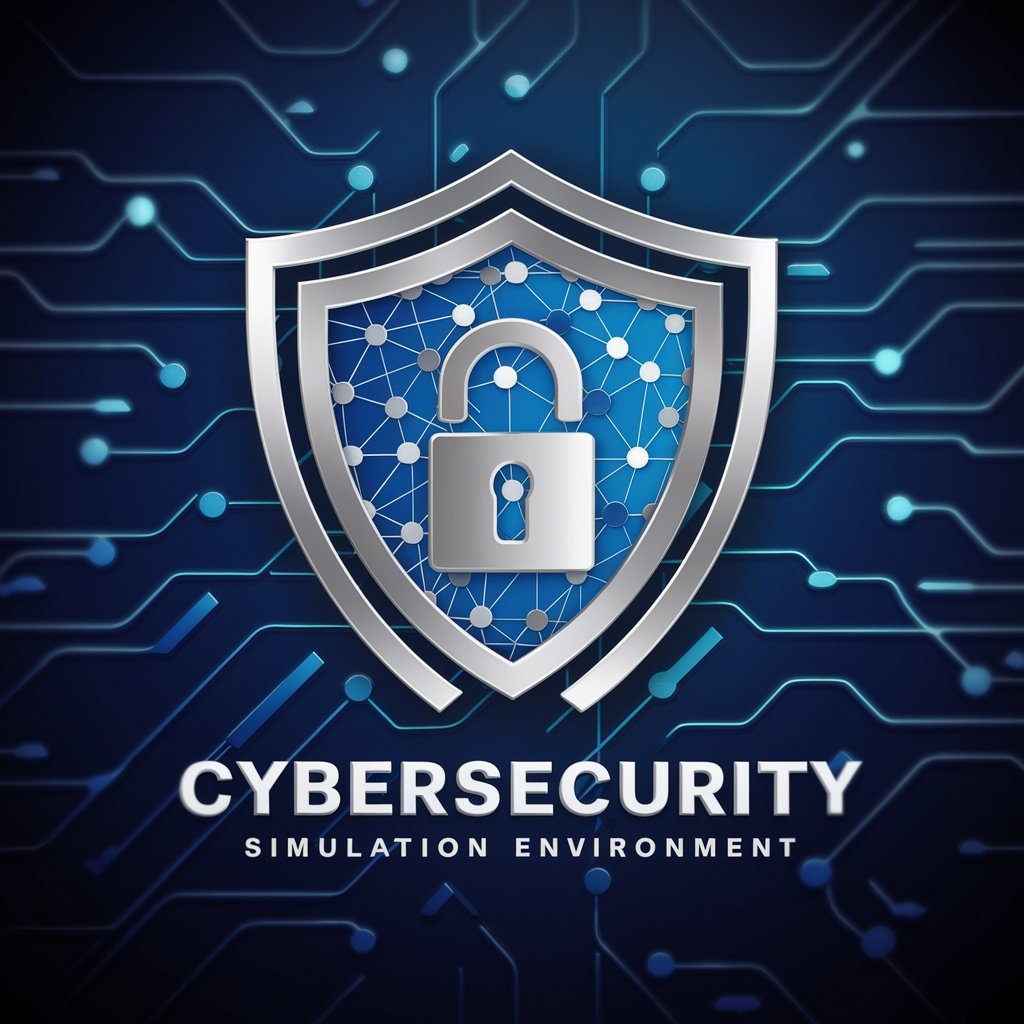Cybersecurity Simulation Environment - Cyber Threat Simulation Platform

Welcome to the Cybersecurity Simulation Environment. Ready to test your defenses?
AI-driven Cybersecurity Training and Simulation
Simulate a phishing attack scenario involving a corporate email system.
Design a malware attack that targets IoT devices in a smart home environment.
Outline the steps for defending against a DDoS attack on an e-commerce platform.
Create a network intrusion simulation for a financial institution's secure database.
Get Embed Code
Overview of the Cybersecurity Simulation Environment
The Cybersecurity Simulation Environment (CSE) is a specialized platform designed to create realistic cyber threat scenarios for educational and research purposes. Its core objective is to simulate various types of cyberattacks, such as phishing, malware distribution, and network intrusions, in a controlled, secure environment. This allows users to engage with and respond to these threats in real-time, facilitating a deep understanding of cyberattack mechanisms and effective defense strategies. For example, a simulation might involve a scenario where users must detect and mitigate a ransomware attack targeting an organization's digital infrastructure, requiring them to implement encryption protocols, backup strategies, and incident response plans to minimize damage and restore system functionality. Powered by ChatGPT-4o。

Key Functions and Real-World Application Scenarios
Attack Simulation
Example
Phishing campaign simulation
Scenario
In this scenario, the CSE generates a simulated phishing campaign targeting the organization's employees. Users are tasked with identifying malicious emails, analyzing their content, and implementing email filtering and employee training programs to reduce the risk of future breaches. This simulation helps organizations strengthen their human firewall and email security protocols.
Network Intrusion Detection
Example
Simulated network breach
Scenario
CSE creates a scenario where an external attacker attempts to breach the organization's network defenses through vulnerabilities in its web application. Participants use intrusion detection systems (IDS) and security information and event management (SIEM) tools to detect, analyze, and respond to the attack. This simulation is crucial for testing the effectiveness of an organization's perimeter security and incident response capabilities.
Malware Analysis
Example
Ransomware attack simulation
Scenario
A scenario where the CSE simulates a ransomware attack encrypting critical files and demanding a ransom. Users are tasked with identifying the malware's entry point, analyzing its behavior, and developing mitigation strategies to recover encrypted data and prevent future incidents. This simulation is vital for understanding malware operation and enhancing organizational resilience against such threats.
Target User Groups for CSE
Cybersecurity Professionals
Individuals working in cybersecurity roles, such as security analysts, network administrators, and incident responders, who need to stay ahead of emerging threats and refine their technical skills through hands-on experience with simulated cyberattacks.
Educational Institutions
Academic institutions offering courses in cybersecurity, computer science, and information technology can integrate CSE into their curriculum to provide students with practical, real-world experience in identifying, analyzing, and mitigating cyber threats.
Corporate Security Teams
Organizations looking to assess and enhance their security posture can use CSE to simulate attacks on their infrastructure, allowing their security teams to practice incident response, threat hunting, and mitigation in a realistic but safe environment.

How to Use Cybersecurity Simulation Environment
1
Start by visiting yeschat.ai for an unrestricted trial, with no requirement for login or a ChatGPT Plus subscription.
2
Choose a cyberattack scenario from the list provided to simulate. Options range from phishing and malware attacks to network intrusions.
3
Configure the simulation parameters according to your needs, including attack complexity, target environment, and desired outcomes.
4
Initiate the simulation. Monitor the attack’s progress, gather data, and evaluate the effectiveness of your current cybersecurity measures.
5
After the simulation, review the detailed reports and recommendations provided to improve your defenses against similar future attacks.
Try other advanced and practical GPTs
Health & Environment Analyst
Transforming Data into Environmental Action

Matrix of Environment Creation
Craft worlds with AI-powered imagination

Simulation Environment for Training
Crafting Smarter AI with Realistic Simulations

Miracle Guide
Empowering your journey with divine guidance

Miru [Miracle Story Teller]
Crafting your narratives, powered by AI
![Miru [Miracle Story Teller]](https://r2.erweima.ai/i/6dowaqEdSwW0j-zmmERD3g.png)
Miracle Sports Predictor (기적의 스포츠 승부 예측)
Predicting sports outcomes with AI-powered precision

Environment Professor GPT
Empowering Environmental Learning with AI

Docker environment creator
Streamline Docker setup with AI

Pro Coding Environment
Elevate Your Coding Skills with AI-Powered Assistance

Webflow Wizard
Empower your Webflow sites with AI

Webflow Wizard
Elevate Your Webflow Projects with AI

Webflow Teacher
AI-powered Webflow expertise at your fingertips

Cybersecurity Simulation Environment Q&A
What is Cybersecurity Simulation Environment?
Cybersecurity Simulation Environment is an advanced AI-driven platform designed to simulate various cyber threats and attacks. It allows users to test and enhance their defense mechanisms in a controlled, virtual setting.
Can I customize the attack scenarios?
Yes, users can fully customize attack scenarios, including the type of attack, its complexity, and the targeted virtual environment. This flexibility helps in preparing for a wide range of cyber threats.
Is it suitable for beginners in cybersecurity?
Absolutely. The environment is designed to cater to all levels of expertise. For beginners, it offers guided simulations with step-by-step instructions and learning materials to understand and mitigate threats.
How does this tool help in improving cybersecurity measures?
By simulating real-world cyberattacks, it provides valuable insights into vulnerabilities and the effectiveness of existing security measures. This hands-on experience is crucial for developing stronger defenses.
What types of cyberattacks can be simulated?
The environment supports a wide range of simulations, from phishing, malware, and ransomware attacks to advanced persistent threats and network intrusions, offering comprehensive training and testing opportunities.
